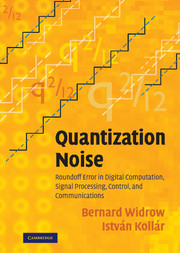 Quantization Noise
Quantization Noise Book contents
- Frontmatter
- Contents
- Preface
- Acknowledgments
- Glossary of Symbols
- Acronyms and Abbreviations
- Part I Background
- Part II Uniform Quantization
- Part III Floating–Point Quantization
- Part IV Quantization in Signal Processing, Feedback Control, and Computations
- Part V Applications of Quantization Noise Theory
- Part VI Quantization of System Parameters
- 21 Coefficient Quantization
- APPENDICES
- Bibliography
- Index
21 - Coefficient Quantization
from Part VI - Quantization of System Parameters
Published online by Cambridge University Press: 06 July 2010
- Frontmatter
- Contents
- Preface
- Acknowledgments
- Glossary of Symbols
- Acronyms and Abbreviations
- Part I Background
- Part II Uniform Quantization
- Part III Floating–Point Quantization
- Part IV Quantization in Signal Processing, Feedback Control, and Computations
- Part V Applications of Quantization Noise Theory
- Part VI Quantization of System Parameters
- 21 Coefficient Quantization
- APPENDICES
- Bibliography
- Index
Summary
The effects of roundoff noise in control and signal processing systems, and in numerical computation have been described in detail in the previous chapters.
There is another kind of quantization that takes place in these systems however, which has not yet been discussed, and that is coefficient quantization.
The coefficients of an equation being implemented by computer must be represented according to a given numerical scale. The representation is of course done with a finite number of bits. The same would be true for the coefficients of a digital filter or for the gains of a control system.
If a coefficient can be perfectly represented by the allowed number of bits, there would be no error in the system implementation. If the coefficient required more bits than the allowed word length, then the coefficient would need to be rounded to the nearest number on the allowed number scale. The rounding of the coefficient would result in a change in the implementation and would cause an error in the computed result. This error is distinct from and independent of quantization noise introduced by roundoff in computation. Its effect is bias–like, rather than the PQN nature of roundoff, studied previously.
If a numerical equation is being implemented or simulated by computer, quantization of the coefficients causes the implementation of a slightly different equation.
- Type
- Chapter
- Information
- Quantization NoiseRoundoff Error in Digital Computation, Signal Processing, Control, and Communications, pp. 565 - 586Publisher: Cambridge University PressPrint publication year: 2008
